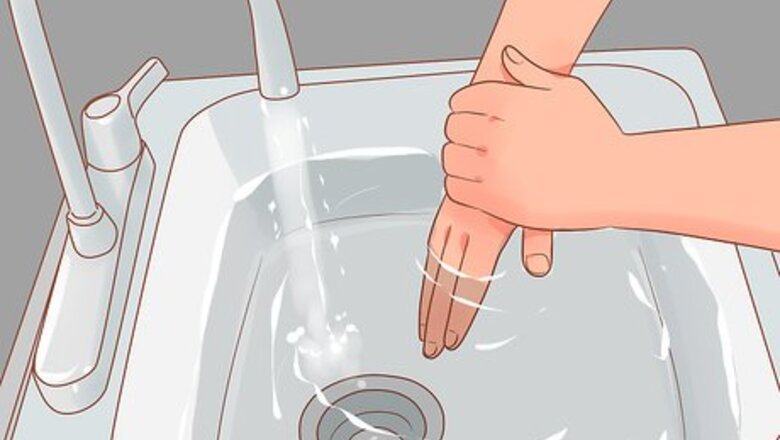
views
Picking up or Transferring the Hamster
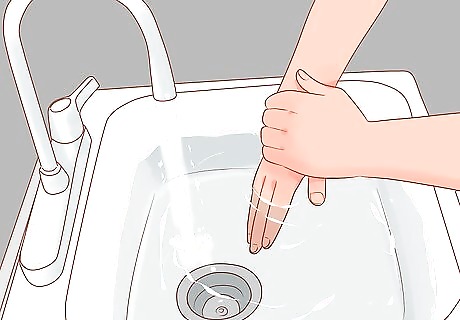
Wash your hands before and after handling a hamster. If your hamster smells food on you, it might think that your hand is food and accidentally bite you. To prevent this from happening, thoroughly wash your hands with soap under a bathroom or kitchen tap before you open your hamster’s cage. Then, once you’re finished holding your hamster, wash your hands again. Hamsters go to the bathroom in their cages, so the animal might not be clean when you handle it. Washing your hands afterward will clean off any fecal matter or germs.
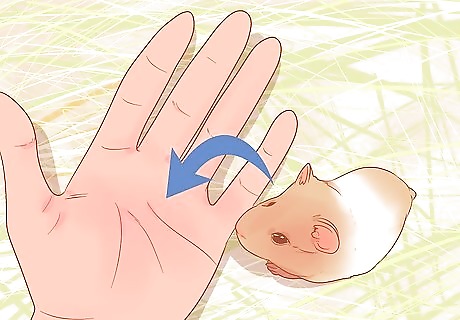
Let the hamster climb into 1 hand and cup your other hand over it. Place 1 hand into the container that the hamster is sitting in. Cup your hand and wait for the animal to climb into it. Once the hamster is sitting in your hand in its cage, cup your other hand and place it over the top of the hamster. Make sure your palm faces downwards when you move your second hand towards your hamster so the hamster doesn't feel like you're going to strike it. Slightly curl your fingers on the hand beneath the hamster to keep it safely in place.
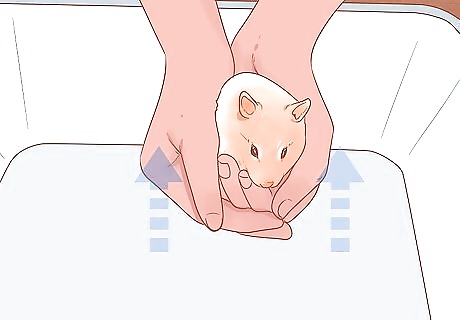
Bring the hamster out of its carrying case and up to your chest. With both hands still cupped around the hamster’s body, lift it up out of the cage. Do this slowly so the hamster doesn’t feel frightened. Bring the animal up to your chest and rest your hands against your sternum. Keeping the hamster against your chest will help it feel safe and secure.
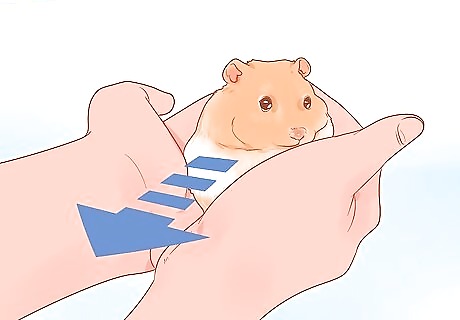
Keep the hamster oriented towards you when you lift it up. If your hamster is facing away from you, it will lose a sense of spatial orientation. To keep the hamster calm, keep its face pointed towards your body and its rear pointed away from you. Once it’s in this position, try not to turn or spin the hamster around when you’re holding it, or it will become disoriented and frightened. A frightened hamster will try to escape from your hands and could hurt itself. If the hamster turns itself to face another direction once you’re holding it, that’s fine. If you’re transferring the hamster into a different cage or carrying case, move the 2 cages as close together as possible. Then pick up the hamster as directed and slowly lower it into the space, then tip your hands forward so the hamster can run out.
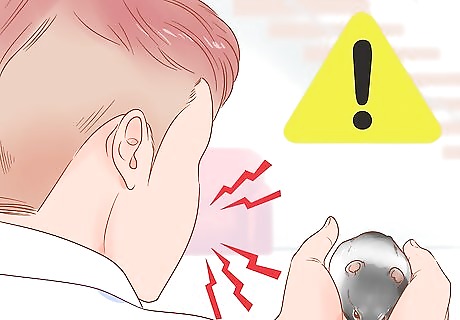
Never yell or grab at a hamster if it bites you. Hamsters will bite out of fear or confusion, but never out of malicious intent. If a hamster happens to bite you as you're attempting to pick it up, pull your hand away. Never strike the hamster if you’re in pain or angry with it, and don’t grab the hamster with your other hand to pull it off of you. If the hamster tries to squirm out of your hands while you're holding it, cup your hands firmly together so the animal can't escape. Be careful not to squeeze or squish the hamster, though. Just take it back to its cage. If your hamster bites you while you're holding it, don't pull your hand away, or you'll drop the hamster on the ground. Unlike with dogs (and sometimes cats), hamsters cannot be trained. Disciplining a hamster won’t teach it not to bite.
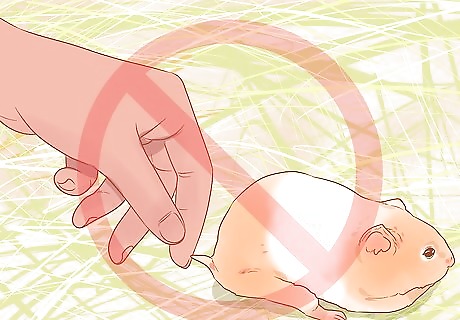
Do not pick the hamster up by its tail or lift it without support. Holding the hamster by its tail could cause damage to the small appendage. This will hurt the hamster and cause it to bite you. Similarly, it will be uncomfortable for the hamster if you hold it with 1 or 2 fingers around its midsection without using your other hand to support it from underneath. Also, never lift the hamster up by 1 or 2 legs. Keep the hamster’s feet supported whenever you’re holding it.
Letting the Hamster Adjust to its Environment
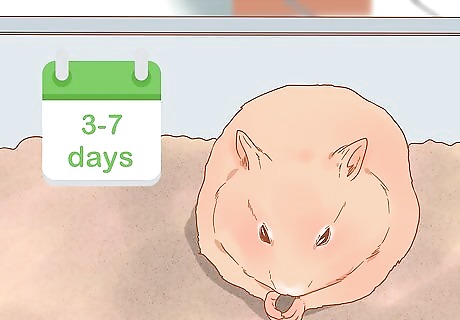
Leave your hamster alone in its cage for 3–7 days. A new hamster will feel nervous when you bring it to a new, unfamiliar environment. Rather than petting and handling the hamster right away, give it time alone in its cage. Over a few days, the hamster will get used to its cage, the room it’s in, and the sound of your voice. If the hamster seems severely nervous (doesn’t eat or drink or huddles in a corner of the cage), try draping a thin piece of cloth over the top and sides of the cage. Don’t let small children come near the hamster for the first week.
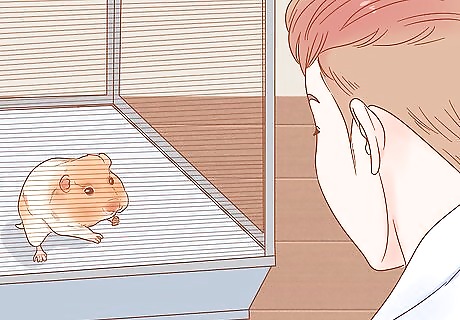
Speak softly to the hamster so it feels comfortable around you. Once your hamster has started to seem more at ease in your room, you can begin using your voice around the animal. Talk quietly at first so you don’t startle the hamster. You don’t have to talk only to the hamster, either; taking a phone call in your room or reading a book out loud will also help the hamster feel comfortable with your voice. Since hamsters are nocturnal creatures, they’ll spend most of the day sleeping. Avoid intentionally waking up a sleeping hamster.
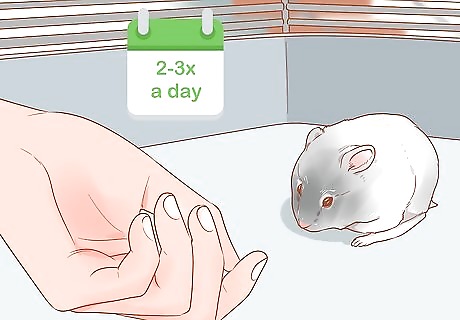
Put your hands into the hamster’s cage 2–3 times a day. Inserting your hands into the hamster cage will allow the animal to become familiar with your smell. It will also help the hamster feel even more comfortable around you and will prepare them for physical touch. A couple of times every day, reach into the hamster’s cage to swap out old toys, change the water and food, and pull out dirty bedding. Remember to wash your hands before each time you put them into the hamster's cage. If your hands smell like food, the hamster will think they're edible and may try to take a bite. At this point, though, don’t actually touch the hamster.
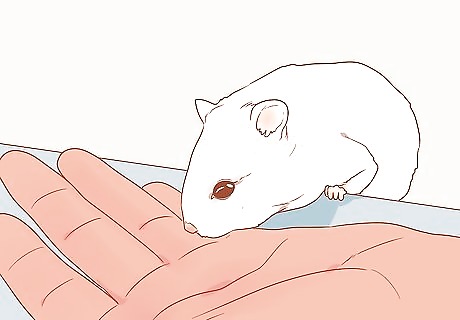
Let your hamster sniff your hand so it knows you're not a predator. Like any other animal, hamsters are naturally cautious around new people and animals. To set your hamster at ease and show it that you’re not going to eat it or harm it in any way, let the hamster approach and sniff your fingers while your hands are in its cage. If the hamster nips at your fingers, pull your hand out and let it sniff at your fingers again the next day.
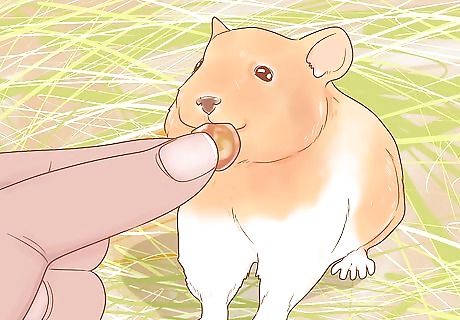
Feed the hamster tasty treats so it associates you with good things. Try setting a treat on the bottom of the cage about 4 inches (10 cm) away from the hamster, and watch as the hamster approaches and eats the treat. Do that for 2-3 days, and then try feeding the hamster by hand. Place a treat on the tip of a finger and hold it near the hamster. If the hamster feels comfortable enough, it will approach and eat the treat off of your finger. Once the hamster is comfortable eating from your hands, try cupping a hand and sliding it beneath your hamster to lift it up.
Helping the Hamster Feel Comfortable Being Handled
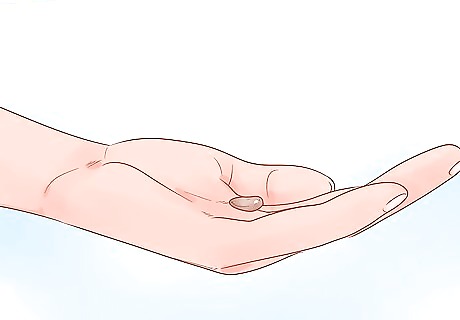
Place a treat in the center of your palm and let the hamster climb up. Once the hamster is used to eating treats off of your fingertips, set your hand on the floor of the cage and place a treat in the center of your palm. The hamster should cautiously approach and, after a few seconds, crawl up into your hand to eat the treat. If the hamster is too cautious or frightened to climb onto your palm, don’t worry. Try again the next day and you might have better results. If the animal bites or nips at your fingers, slowly pull them away and up out of the cage. Move to the next step when the hamster shows signs of being comfortable in your palm. A comfortable hamster will eat from your hand. It will also drink when you’re around and play with its toys.
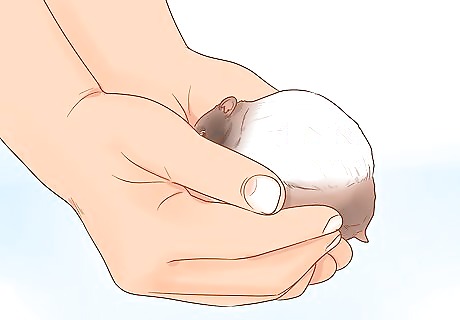
Elevate your hand while the hamster is sitting in your palm. Pick your hand up off of the cage floor by about 2–3 inches (5.1–7.6 cm) while the hamster sits and eats in your palm. The hamster will sense the motion and realize that you’re carrying it. While it may seem skittish the first time you lift it up, the animal will quickly become used to physical contact. In order to calm the hamster and prevent it from leaping out of your hand, cup your hand around the hamster and hold it against your chest. It’s fine if the hamster jumps off your hand at first. Try to handle it every day so that, over time, it becomes used to the sensation of being held.
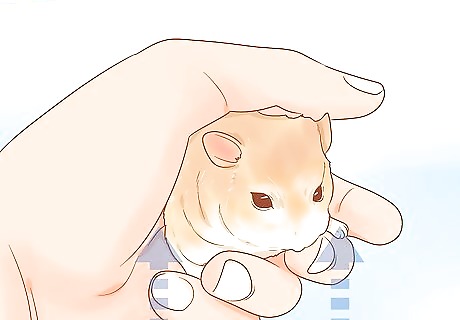
Pick the hamster up with 1 hand once it’s comfortable being lifted. Once you’ve held your hamster against your chest half a dozen times, try picking it up with just 1 hand. Scoop the hand beneath the hamster while it’s in the cage and gently lift the animal up and out of the enclosed area. Hold your hamster for 1-2 minutes at a time and then put it back in its cage. Keep your hand between 1–2 feet (30–61 cm) above a tabletop the first few times you try this, so the hamster won’t hurt itself if it jumps from your hand.
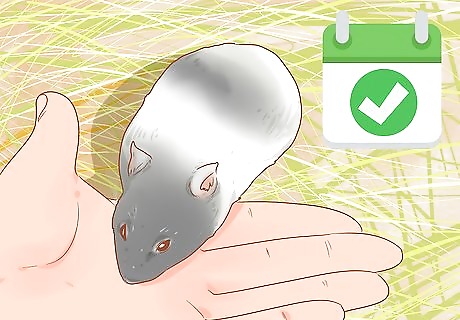
Lift the hamster daily for a month until it’s used to being handled. Repeat the previous 2 steps daily: hold a treat in your hand, let the hamster climb up, and lift the hamster up into the air slightly. Once you’ve done this for a full month, the hamster should feel completely comfortable when you’re handling it. If you have an outgoing hamster, you may only need to do this for 2 weeks before it’s ready to be picked up.

Handle your hamster every 1–2 days. Once they’re familiar with their owner(s), hamsters love being handled and held. Pick them up every day or every other day to help socialize the animal and get it used to its environment. You can even walk around with your hamster in your hands. Hold the hamster against your chest for stability and safety. If you go a few days without handling your hamster, it may be less comfortable (and even try to bite) when you do pick it up again. Earn its trust back by letting it eat a few treats out of your hand.















Comments
0 comment